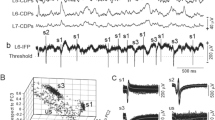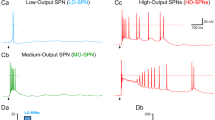Summary
Examination of cutaneous receptive fields (RFs) of lamina 5 cells in the lumbar spinal cord of decerebrate cats shows them to have three distinct zones with respect to mechanical and electrical stimulation. The mean response rate to both mechanical and electrical stimulation in zone 1 increases steadily up to the highest strengths used; in zone 2, surrounding zone 1 mainly proximally, mild stimuli reduce the mean rate, stronger stimuli increase it; in zone 3, mainly proximal to zone 2, all stimuli reduce the rate.
Temporally, zone 1, electric shocks near threshold produce bursts of firing followed by inhibition. With increased stimulus strength, the bursts lengthen to a second or more. In zones 2 and 3, inhibition at all strengths is preceded at higher strengths by bursts of firing.
Cold-blocking the spinal cord at lower thoracic levels reversibly increases the ongoing activity of these cells, increases the area of zones 1 and 2, and almost completely suppresses all inhibition.
Stimulation of dorsal columns and threshold stimulation of distant dorsal roots inhibits ongoing and induced activity. Barbiturate decreases ongoing activity and the duration of firing produced by cutaneous electrical stimulation but does not decrease inhibition.
These results are consistent with a model in which low-threshold fibres are excitatory only over a small central area of the RF of a lamina 5 cell (zone 1), high threshold fibres are excitatory over a larger area (zones 1 and 2), and low threshold fibres are inhibitory over the entire receptive field (zones 1, 2 and 3) with a slower time-course. This inhibition is tonically enhanced by descending influences in the decerebrate cat.
It is suggested that the high and low threshold fibres correspond approximately to the small and large diametre fibres whose balance is the basis for the coding of pain in the theory of melzack and wall.
Similar content being viewed by others
References
Andersson, S.A.: Projection of different spinal pathways to the second somatic sensory area in cat. Acta physiol. scand. 56, suppl. 194 (1962).
Bishop, G.H.: Neural mechanisms of cutaneous sense. Physiol. Rev. 26, 77–102 (1946).
Burgess, P.R., and E.R. Perl: Myelinated afferent fibres responding specifically to noxious stimulation of the skin. J. Physiol. (Lond.) 190, 541–562 (1967).
Collins, W.F., F.E. Nulsen and C.T. Randt: Relation of peripheral nerve fibre size and sensation in man. Arch. Neurol. (Chic.) 3, 381–397 (1960).
Downman, C.B.B.: Skeletal muscle reflexes of splanchnic and intercostal nerve origin in acute spinal and decerebrate cats. J. Neurophysiol. 18, 217–235 (1955).
—, and A. Hussain: Spinal tracts and supraspinal centres influencing visceromotor and allied reflexes in cats. J. Physiol. (Lond.) 141, 489–499 (1958).
Eccles, J.C.: The mechanism of synaptic transmission. Ergebn. Physiol. 51, 299–430 (1961).
—, R.M. Eccles and A. Lundberg: Types of neurone in and around the intermediate nucleus of the lumbosacral cord. J. Physiol. (Lond.) 154, 89–114 (1960).
Fetz, E.: Pyramidal tract effects on interneurons in the cat lumbar dorsal horn. J. Neurophysiol. 31, 69–80 (1968).
Frank, K., and M.G.F. Fuortes: Unitary activity of spinal interneurons in cats. J. Physiol. (Lond.) 131, 425–435 (1956).
Gordon, G., and M.G.M. Jukes: An investigation of cells in the lateral cervical nucleus of the cat which respond to stimulation of the skin. J. Physiol. (Lond.) 169, 28–29P (1963).
Hongo, T., E. Jankowska and A. Lundberg: Post-synaptic excitation and inhibition from primary afferents in neurones in the spinocervical tract. J. Physiol. (Lond.) 199, 569–592 (1968).
—: Convergence of excitatory and inhibitory action on interneurones in the lumbosacral cord. Exp. Brain Res. 1, 338–358 (1966).
Horrobin, D.F.: The lateral cervical nucleus of the cat. J. exp. Physiol. 51, 351–371 (1966).
Hunt, C.C., and A.K. McIntyre: An analysis of fibre diametre and receptor characteristics of myelinated cutaneous afferents in cat. J. Physiol. (Lond.) 153, 99–112 (1960).
Iggo, A.: The Skin Senses. In: Electrophysiological and histological studies of cutaneous mechanoreceptors, pp. 84–111. Ed. by D.R. Kenshalo. Springfield/Illinois: Charles C. Thomas 1968.
Lundberg, A., and O. Oscarsson: Three ascending spinal pathways. Acta physiol. scand. 51, 1–16 (1961).
Melzack, R., and P.D. Wall: Pain mechanisms: a new theory. Science 150, 971–979 (1965).
Mendell, L.M.: Responses of single dorsal cord cells to peripheral cutaneous fibres. Exp. Neurol. 16, 316–332 (1965).
—, and P.D. Wall: Responses of single dorsal cord cells to peripheral cutaneous unmyelinated afferents. Nature (Lond.) 206, 97–99 (1965).
Noordenbos, W.: Pain. Amsterdam: Elsevier 1959.
Pomeranz, B., P.D. Wall and W.V. Weber: Cord cells responding to fine myelinated afferents from viscera, muscle and skin. J. Physiol. (Lond.) 199, 511–532 (1968).
Sherrington, C.S., and S.C.M. Sowton: Observations on reflex responses to single break shocks. J. Physiol. (Lond.) 49, 331–343 (1915).
Taub, A.: Local, segmental and supraspinal interaction with a dorsolateral spinal cutaneous afferent system. Exp. Neurol. 10, 357–374 (1964).
—, and P.O. Bishop: The spinocervical tract: dorsal column linkage, conduction velocity, primary afferent spectrum. Exp. Neurol. 13, 1–21 (1965).
Wall, P.D.: Excitability changes in afferent fibre terminations and their relation to slow potentials. J. Physiol. (Lond.) 142, 1–21 (1958).
—: Repetitive discharge of neurons. J. Neurophysiol. 22, 303–320 (1959).
—: Two transmission systems for skin sensations. In: Sensory Communications, pp. 475–496. Ed. by W. Rosenblith. Cambridge: The M.I.T. Press 1961.
Wall, P.D.: Impulses recorded in the region of dendrites. J. Physiol. (Lond.) 180, 116–133 (1965).
—: The laminar organisation of dorsal horn and effects of descending impulses. J. Physiol. (Lond.) 188, 403–423 (1967).
—, and R. Cronly-Dillon: Pain, itch and vibration. Arch. Neurol. (Chic.) 2, 365–375 (1960).
—, J. Freeman and D. Major: Dorsal horn cells in spinal and freely moving rats. Exp. Neurol. 19, 519–529 (1967).
Wickelgren, B.G.: Habituation of spinal interneurons. J. Neurophysiol. 30, 1404–1423 (1967).
Wolbarsht, M.L., H.G. Wagner and E.F. MacNichol: The Visual System. In: Neurophysiology and Psychophysics, pp. 170–175. Ed. by R. Jung and K. Kornhuber. Berlin-Göttingen-Heidelberg: Springer 1960.
Zotterman, Y.: Touch, pain and tickling. An electrophysiological investigation of cutaneous sensory nerves. J. Physiol. (Lond.) 95, 1–28 (1939).
Author information
Authors and Affiliations
Additional information
Wellcome Trust Fellow, on leave of absence from the Weizmann Institute of Science, Israel.
Rights and permissions
About this article
Cite this article
Hillman, P., Wall, P.D. Inhibitory and excitatory factors influencing the receptive fields of lamina 5 spinal cord cells. Exp Brain Res 9, 284–306 (1969). https://doi.org/10.1007/BF00235240
Received:
Issue Date:
DOI: https://doi.org/10.1007/BF00235240




